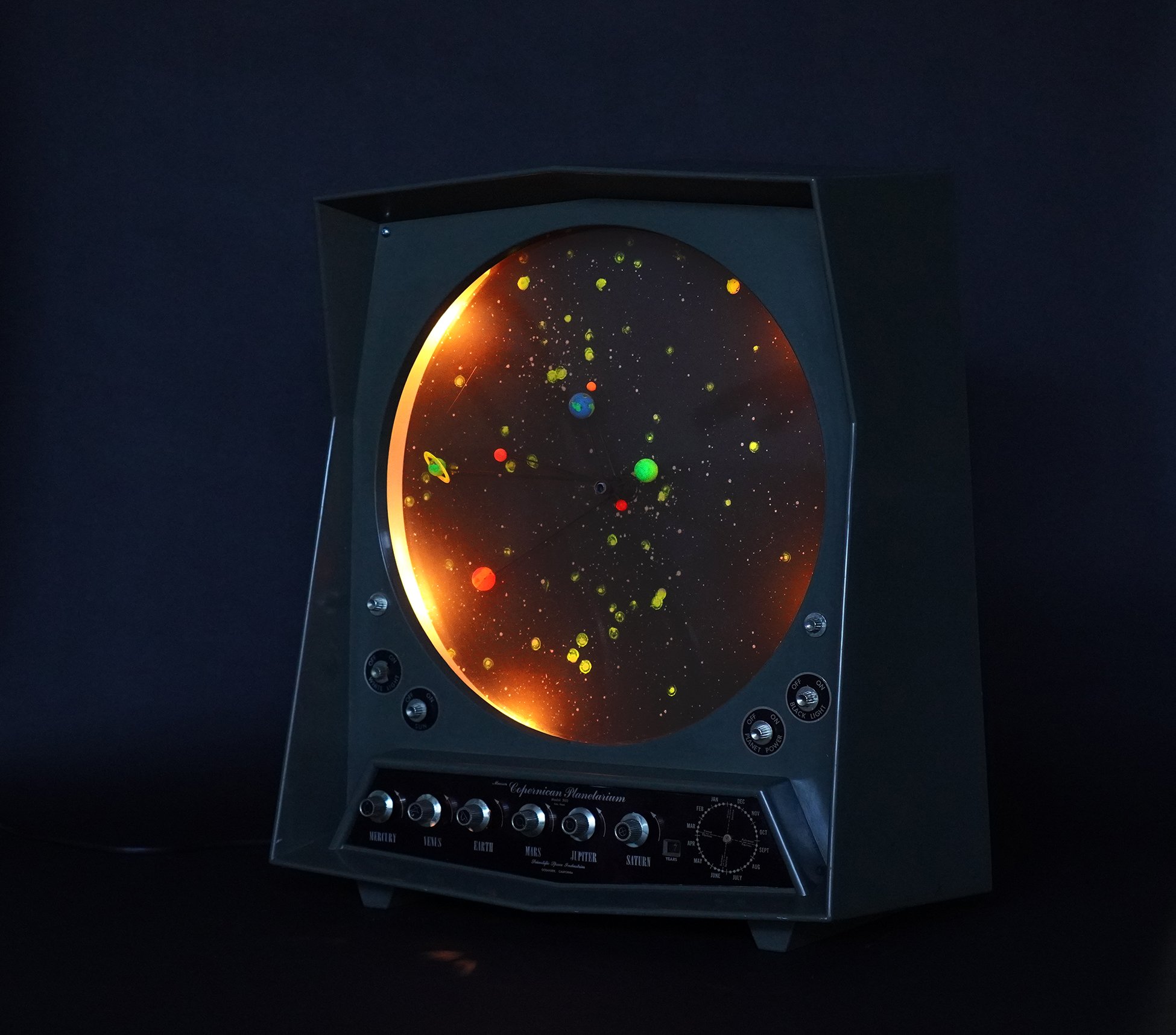MUSSER PLANETARIUM MODEL 500 C. 1960 (Seattle Worlds Fair)
MUSSER PLANETARIUM MODEL 500 C. 1960 (Seattle Worlds Fair)
The Musser Copernican planetarium was created in 1960 and was introduced in the Seattle World Fair in 1962 — it is a teaching orrey for the classroom that was only available at the worlds fair for purchase. This is not a toy but rather a sophisticated planetarium designed by Dr. Claire O. Musser and was built by Scientific Space Industries, a division of Hughes Aircraft Company Vacuum Tube Products Division. It is a large piece measuring 25” H x 19” W x 9.25” D. It is somewhat similar to a large TV set of this era. It has various settings and light controls. The blacklight setting illuminates the planets in the most amazing way that looks like a window into space. You can control the speed of each planet ( might need some adjustments due to age) and the dial corresponds with accurate time (years) and months to the various relationships to the planets. I have a video posted below of the piece in action (from the first unit I had—this is the second). Comes with two overlays. You could buy many different overlays for the classroom and this unit typically came with two that are stored in the back—this unit has the two pictured.
Condition report:
Everything is in decent working order (needs a tiny bulb replaced for the sun) , some normal scuffing — on the top some surface divots from cleaning not sure but about 1 1/4 diameter on right side (but on top so not distracting) some knobs have chipped edges—indicator arrow on months needs to be replaced, and back bottom rear panel that stores discs not on unit but a does not affect units operation in anyway—unit could use some minor adjustments for fine tuning controls but planets still rotate very well. Below is technical excerpt from Christies auction describing the piece:
The Musser Copernican Planetarium Model 500,
an unusual electrical orrery, made by Scientific Space Industries OCEANSIDE, CALIFORNIA, in form similar to a large television set, with a circular 17 1/8in. (43.6cm.) diameter perspex viewing screen, behind which is a black and white photographed night sky with numerous stars of various magnitudes, in the centre a bulb with red perspex cover protruding from the screen to represent the sun, on plastic arms from the bulb's support socket are painted planet balls: Mercury (red), Venus (green), Earth (green) with attached Moon ball (orange), Mars (dark orange), Jupiter (orange and yellow) and Saturn (green, with yellow rings), in addition three hemispheres are moulded onto the background and painted yellow and orange to represent Uranus, Neptune and Pluto, in a grey plastic housing, at the base of which are six knobs with the planetary symbols and names which can be turned anti-clockwise to move the planet balls and a counter for the years, in addition there is a scale with index for the months of the year also showing the equinoxes and solstices, further knobs turn on or off White Light, Black Light, the Sun and the Planet Power, with separate clear perspex cover for the viewing screen, the reverse applied with a label for SCIENTIFIC SPACE INDUSTRIES COPERNICUM PLANETARIUM CREATING A NEW WORLD WITH ELECTRONICS HUGHES AIRCRAFT COMPANY VACUUM TUBE PRODUCTS DIVISION OCEANSIDE, CALIFORNIA, serial number 694, the whole housing -- 24 ¼in. (61.6cm.) high…













